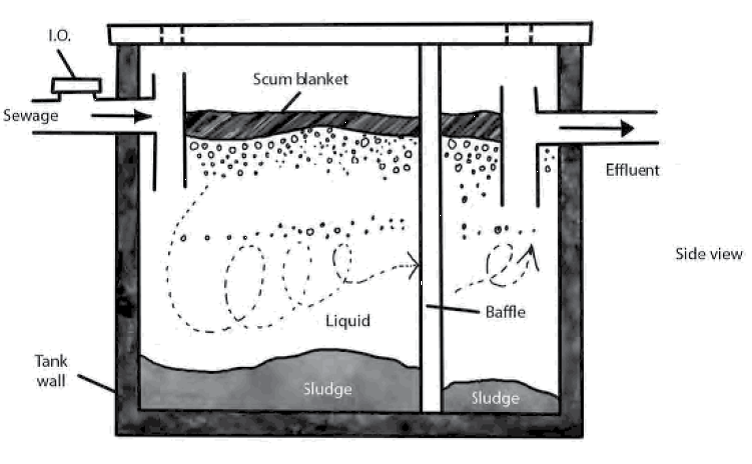Drainage and Sewage Management
Drainage and Sewage Management
General guidelines for drainage and sewage system
- Drainage system should be closed i.e. no open drains in the hospital premises
- All the open drains should be properly covered
- Gradients of the drainage system should be conductive for maintaining the flow of water
- All the drains should be periodically checked for any blockage
- Regular cleaning (preferably once in week) of the drains needs to be carried out, as per cleaning schedule of the hospital
- The drainage and sewage system of the hospital should be connected with municipal sewage and drainage system
- In the absence of connectivity with municipal drainage and sewage system, hospitals need to have their own sewage management system in place within the premises.
Construction of septic tanks (On site sewage management)
Septic tank offers a preliminary treatment of sewage prior to final disposal. Sewage is held in these tanks for some prescribed period during which time the suspended solids present in the storage settle down. The settled sludge and the supernatant liquor undergo anaerobic digestion. The digestion results in appreciable reduction in the volume of sludge and reduction in organic matter in the liquid.
Unsatisfactory design, construction and maintenance of septic tanks constitute a health hazard. It is, therefore, considered essential to have planned septic tanks or onsite sewage system in place.
Normally, septic tanks are designed for foul sewage (faecal matter and urine). Sullage wastes may be distributed crudely by throwing on the gardens or grassed areas and so dispersed and absorbed, or may be drained to a seepage pit or dispersion trench from which it overflows into or is absorbed by the surrounding soil. However it is to be ensured that under no circumstances should effluent from a septic tank be allowed into an open channel drain or body of water without adequate treatment.
Location of Septic Tank
Septic tank should be located at a place open to sky, as far away as possible from the exterior of the wall of building and should not be located in swampy areas or areas prone to flooding. It should also be accessible for cleaning.
Layout and Construction Considerations
- The layout should be as simple and direct as practicable
- The pipes should be laid, as far as possible, in straight lines in both vertical and horizontal planes; however, where bends are unavoidable, they should be long radius bends with cleaning eyes
- Anything that is likely to cause irregularity of flow should be avoided
- At junctions of pipes in manholes, direction of flow from a branch connection should not make an angle exceeding 45 degree with the direction of flow in the main pipe
- The floor of the tank needs to be water tight and of adequate strength to resist earth movement and to support the weight of the tank, walls and contents. The floor should be provided with a minimum slope of 1: 10, towards the sludge outlet to facilitate desludging
- The walls should be of such thickness as to provide adequate strength and water tightness. Walls built out of brick should not be less than 200 mm thick and should be plastered to a minimum thickness of 12 mm inside and outside with cement mortar. They should have a minimum thickness of 370 mm.
Note: For detailed design parameters of the septic tanks please refer to “Indian Standard Code of Practice for Installation of Septic Tanks Part 1 Design Criteria and Construction (Second Revision)”
Commissioning of Septic Tank
- The sewerage system should be complete and ready for operation before connection is made to the building
- The tank should be filled with water to its outlet level before the sewerage is let into the tank. It should, preferably, be seeded with small quantities of well digested sludge obtained from septic tanks or sludge digestion tanks
- In the absence of digested sludge a small quantity of decaying organic matter, such as digested cow dung may be introduced.
Sludge Withdrawal
- Half yearly or yearly desludging of septic tank is desirable
- Normally, the tanks need to be cleaned when the sum of the depth of the scum and the sludge is observed to exceed half the depth of the tank
- A portion of sludge not less than 25 mm in depth should be left behind in the tank bottom which acts as the seeding material for the fresh deposits
- Manual handling of sludge should be avoided
- Spreading of sludge on the ground in the vicinity should not be allowed.

Problem Signs in Septic Tanks
The septic tank needs to be checked if there are signs that it is not working properly.
Some signs that a septic tank is not working properly are:
- The sewage in the toilet or the liquid waste from other fixtures flows away very slowly
- Liquid waste overflows from the disconnector trap
- Wet areas are seen at the top of the septic tank
- There is a strong unpleasant smell near the septic tank
- The grass around the tank is very green and growing well.
These signs may indicate problems with the drain. Therefore, these drains will need to be checked at the same time as the septic tanks are checked.
Source: : Guidelines For Implementation Of "KAYAKALP" Initiative
Last Modified : 3/31/2020
